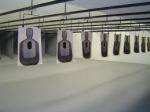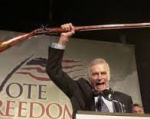When I was a kid growing up in New York City we kept our eyes on a neighborhood gang whose older members, when it came to violence and lawlessness, put the feared Westies from Hell’s Kitchen to shame. In fact, the Westies contracted out their hits to this bunch on my block, whose SOP was to haul the victim up to the roof of one of the neighborhood housing projects and that was that. Five guys go up to the roof, four guys walk back down.
As tough and brutal as they were, the members of this crew never carried guns. Why not? Because whenever anything went down in the neighborhood, the cops would come around, line them up against the wall, administer the Miranda warning by kicking them in the ass or punching them in the face, and then pat them all down for guns. If the cops found a gun, that guy was slammed into the back of the patrol car and wasn’t seen for a long time. Don’t think for one second that aggressive, in-your-face street patrols used by Giuliani and Bloomberg to drive down gun crime in New York City is such a new idea.
 The NRA and the gun industry wants us to take a giant leap of faith by going along with their idea that the most effective way to curb gun violence is to cut down on crime. But the data on gun violence published by the FBI doesn’t support this, not at all. Of course there are criminals out there who use guns to commit crimes. Of course we need to do everything possible to keep guns out of the wrong hands. But the connection of guns to gun violence is more complicated than just the simple idea that more guns in the “wrong hands” equals more crime.
The NRA and the gun industry wants us to take a giant leap of faith by going along with their idea that the most effective way to curb gun violence is to cut down on crime. But the data on gun violence published by the FBI doesn’t support this, not at all. Of course there are criminals out there who use guns to commit crimes. Of course we need to do everything possible to keep guns out of the wrong hands. But the connection of guns to gun violence is more complicated than just the simple idea that more guns in the “wrong hands” equals more crime.
According to the FBI, from 2000 to 2012 there were slightly more than 200,000 homicide victims of which slightly more than two-thirds were killed with guns. This is an average of 10,400 gun homicides each year, a remarkably-stable number over the past thirteen years. Of these gun killings, slightly more than 15% involved women as victims, or roughly 21,000 over the same span of years. When women are homicide victims, most if not virtually all of these shootings grow out of some sort of IPV. Let’s not forget, incidentally, that men are also shot to death by women an average of 700 times per year. Taken together, domestic violence probably claimed more than 2,200 victims annually between 2000 and 2012, or one-fifth of all gun fatalities during those years.
The degree to which homicide grows out of personal disputes is shown by the fact that of the total murders committed in 2012, only slightly more than 20% took place during the commission of other crimes. The rest happened because people who knew each other, and in most cases knew each other on a long-term, continuous basis, got into an argument about money, or who dissed who, or who was sleeping with someone else, or some other dumb thing. And many times they were drunk or high on drugs, but no matter what, like Walter Mosley says, “sooner or later” the gun goes off.
Here’s the bottom line on gun violence and crime. Every year 20,000+ shoot themselves intentionally, which is suicide. Another thousand, give or take a hundred, kill themselves accidentally with a gun. Then another 10,000 use a gun to kill someone else, but 8,000 of those shootings have nothing to do with other violent crimes. If we define gun violence as using a gun to end a human life, the FBI is telling us that less than 10% of those fatalities would be eliminated if we got rid of all violent crime. The NRA can try to convince its membership that the reason for gun violence is that there’s too much crime, but the data from the FBI clearly indicates that the reason for gun violence is that there are too many guns.
Get it at Amazon.








Recent Comments